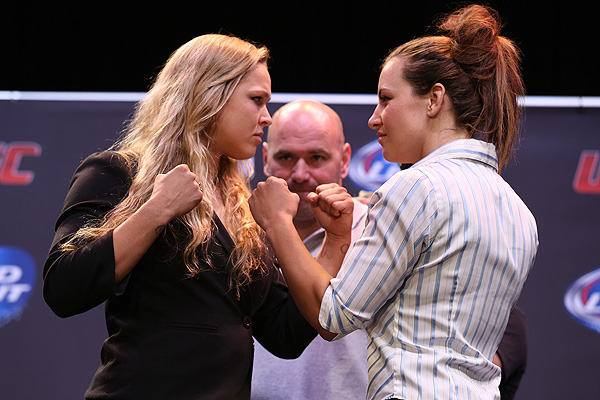Fight Medicine: Uneven Scales

Ronda Rousey, like most mixed martial artists, cuts weight to
compete. | Photo: Dave Mandel/Sherdog.com
Ronda Rousey stirred controversy within the mixed martial arts community when she demonstrated her ability to rapidly cut weight during Season 18 of “The Ultimate Fighter.”
The Ultimate Fighting Championship women’s bantamweight titleholder will likely undergo the same process as she prepares to defend her crown against Miesha Tate in the UFC 168 co-main event on Dec. 28 in Las Vegas. While the dangers of weight cutting are known, the window for a safe cut and the subsequent effects may differ for women.
Advertisement
College programs were encouraged to develop and utilize a weight management program that included hydration testing, with a specific gravity measurement not to exceed 1.025. Specific gravity is a way of testing how much a person is dehydrated, and it can be done by using a refractometer to measure the specific gravity of urine. Furthermore, a minimum weight class was determined for each wrestler through a body fat assessment, with no less than seven percent for males and 12 percent for females, and a program to monitor an average weight loss of 1.5 percent a week. The natural physiological tendency of females to have higher percentages of body fat dictates to what weight classes they can safely cut. For some college programs, a minimum of five percent body fat is necessary to even participate. Interestingly enough, several studies have shown that wrestlers actually perform better at higher percentages of body fat, so it becomes a see-saw between maximizing strength-to-weight ratios and maintaining a high enough level of body fat and lean body mass to optimize performance.
Women mixed martial artists may find it more difficult to make weight as routinely as their male teammates. Hormone levels may factor into making it harder for women to deplete themselves of water and glycogen weight. Hormonal levels in men tend to be more stable, whereas women may have more cyclical changes. Women typically have a lower body weight than men (this limits the total amount of weight women can lose), a higher percentage of body fat (this limits the relative amount of water weight women can lose) and less muscle mass (this limits the relative amount of weight that can be lost from glycogen, which is stored within the muscle and liver). Also, fat, like all lipids, is hydrophobic, meaning it repels water. As a result, an increase in body fat decreases the amount of mass that will be affected by a water cut. Since hormones such as estrogen and progesterone fluctuate -- these hormones affect water retention and energy metabolism -- being able to make a cut, especially water, is more unpredictable in females.
Interestingly, a 2003 study looked at the explosive power of women and men after cutting weight in a sauna. In addition to being an unhealthy weight-cutting practice, it actually affected women’s squat strength but not men’s. Despite being rehydrated after the weight cut, the squat jump ability remained lower than in pre-sauna levels and was directly related to the percent reduction of body weight.
Another topic that may find its way into women’s MMA is the concept of the “Female Athlete Triad,” which is defined as Anorexia, or low available energy and poor nutrition; Amenorrhea, or lack of menstrual cycles; and Osteoporosis, or thinning of the bones.
It has been estimated that up to 15 percent of female athletes experience all three of these symptoms, although men can also experience anorexia and osteoporosis. Hopefully, no one will incorrectly see the amenorrhea and loss of hormonal cycling aspect of the female athlete triad to mean weight cutting may be easier; but everyone should be aware of the real risk of bone fractures from the weakened osteoporotic bones. While weight-cutting practices continue to be re-evaluated across MMA, the issue may be even more important for the females who populate the sport.
Jon Gelber is Sherdog.com’s resident “Fight Doctor.” Want your question answered by The Fight Doctor in the Fight Medicine Mailbag? You can contact him by email at fightmedicine@sherdog.com or follow him on Twitter @fightmedicine. You can also read more about MMA Injuries, Health, and Training at FightMedicine.net.
Related Articles







